On Penobscot Bay: Training the next generation of sea captains, ship engineers, marine scientists
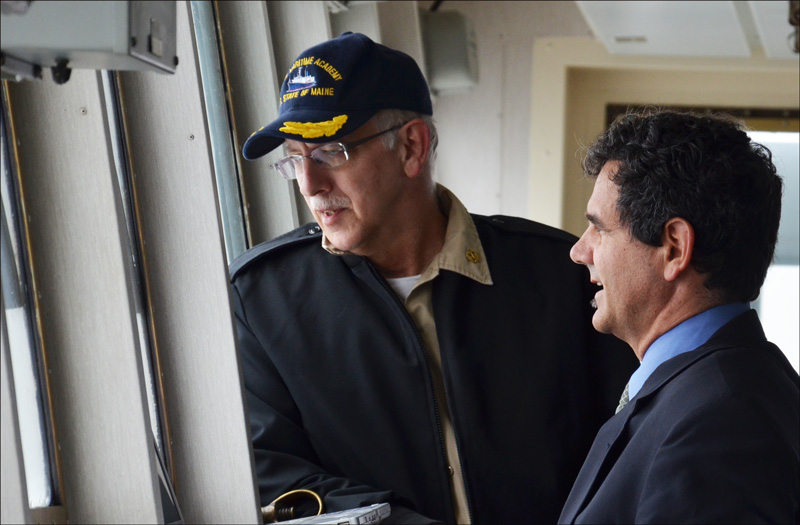
CASTINE — Captain David Gelinas has stood on the bridge of the State of Maine 18 times, maybe more, over the past 30 years, helping to maneuver the 16,000-ton vessel in and out of Castine Harbor. First as a student at Maine Maritime Academy in the early 1980s, and now as a a pilot with the Searsport-based Penobscot Bay and River Pilots Association, he is familiar with the ebb and flow of currents, and the idiosyncracies of the vessel. Still, his gaze bores intensely down at the harbor, as he waits for that second when the tide changes and he knows it is time to slip the ship's stern around to catch the outgoing current of the Bagaduce River.
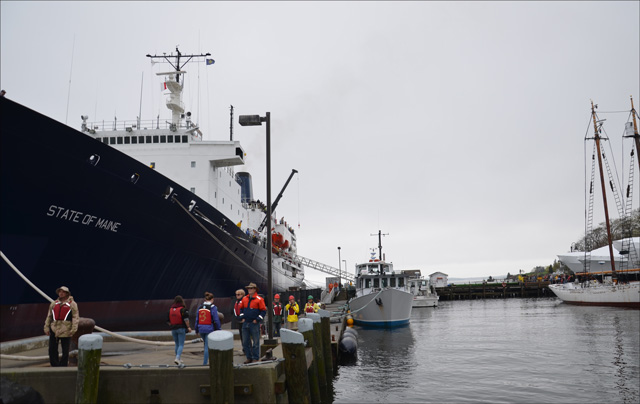
Maine Maritime Academy's training ship, the State of Maine, lies tied up for most of the year to the college's dock in Castine Harbor. Students live aboard, take classes, run its engines, even jump off its sides in an annual tradition. But in May, its lines are cast off and the ship takes freshmen and juniors across the Atlantic, or up and down the North American coastline for maritime training. The ship left May 9 with 240 students aboard. (Photo by Lynda Clancy)
The signs, the smallest even, are there: Eddies in the water change shape, and seaweed begins to flutter in the opposite direction — This navigation is both a science and an art, and anything can go wrong should he or the ship's captain, Leslie B. Eadie, III, fail to judge distance, timing and tidal forces. The ship will be turned around in the harbor with the help of two tugboats, the Fournier Tractor and the Pentagoet, MMA's training tugboat, under the command of Captain Harry Stevens.
If that's not tense enough, they have with them 240 maritime students, a whole new generation of mariners who learning the skills necessary to move enormous ships across oceans, or tugboats that push their freighters along, or engineers who service the engines that do all the work.

MMA students come from Maine, Washington state, Alaska, and other farflung homes to learn at what is considered one of the best maritime colleges in the country. (Photo by Lynda Clancy)
Gelinas, along with the four other licensed captains who pilot ships up and down the east and west sides of Penobscot Bay, and the tugboat captains, like John Worth of Belfast, are fixtures in the year-round business of large working vessels.
National Maritime Day, May 18, will be celebrated at Heritage Park in Belfast. The public is invited to attend the event, which is hosted by thePropeller Club of the U.S., Searsport & Bucksport Chapter
Read more...
Pilots and Tugs: The Quite Guides of Penobscot Bay
The Penobscot Bay Pilots are all MMA graduates, and they have grown to know the bay like the back of their hand, which is reassuring for the tankers and freighters that come and go from Mack Point in Searsport, and other ports in the bay and Penobscot Bay to Brewer.
By law, these captains are responsible for guiding any vessel required to take a pilot upon the waters of Penobscot and Frenchman Bay as well as the Penobscot River. From Searsport, they transfer themselves by their own pilot boats to board vessels at offshore pilot stations, 24 hours a day, 365 days a year to help navigate them to their destination. Then, once their business is done, they escort them from state waters back out to sea again. Maine's marine jurisdictional boundaries extend toward the ocean by three nautical miles, and in Penobscot Bay, that applies to waters around Matinicus and the outer islands.
 John Worth, a Captain for Penobscot Bay Tractor Tug Company and the Maine State Ferry Service, takes the Fournier Tractor tugboat to help move the State of Maine down the bay. Worth has a long association with MMA, having run the schooner Bowdoin for the academy, and he taught tug and barge operations there. He carries a 1,600-ton master steam and motor, with a towing endorsement and 100 ton auxiliary sail, near coastal, U.S.C.G. license. He is currently a Maine State Pilot Commissioner. (Photo by Lynda Clancy)
John Worth, a Captain for Penobscot Bay Tractor Tug Company and the Maine State Ferry Service, takes the Fournier Tractor tugboat to help move the State of Maine down the bay. Worth has a long association with MMA, having run the schooner Bowdoin for the academy, and he taught tug and barge operations there. He carries a 1,600-ton master steam and motor, with a towing endorsement and 100 ton auxiliary sail, near coastal, U.S.C.G. license. He is currently a Maine State Pilot Commissioner. (Photo by Lynda Clancy)
On May 9, it was the annual cast-off of MMA's training ship cruise, an intergral part of the maritime college's curriculum. Every spring, the school sends freshmen and juniors on an Atlantic journey, during which they practice what they've learned in classrooms or aboard the ship the previous nine months while it is tied up at the Castine dock. Gelinas was there on the State of Maine bridge to pilot the ship down the bay toward sea. Once past Rockland, Capt. Eadies would resume his control of the ship.
"We'll get the stern out into the big deep water," said Gelinas. "High tide is at 11:37 a.m. As long is the tide is going up the Bagaduce River, we don't want to go."
This year, the eight-week training cruise is bound for New York, Maryland, Tampa, then to San Juan, and back up the coast to Quebec City. MMA students are drawn from across the country to attend the four-year college that concentrates on engineering, management, marine science and transportation. Many of the students are from Maine, and following graduation, students — 98 percent of them, according to the latest data — find jobs, heading to merchant ships, to the Navy, to power plants, science labs, sailing ships and driving tugboats.
MMA has been training mariners since 1941, and its current State of Maine is the former USNS Tanner, a Navy oceanographic research vessel that the college acquired in 1997. The ship is 500 feet in length, with a beam of 72 feet.

There are 12 female students aboard the MMA cruise this year, including these three freshmen: Haley Eckert, of Harrington; Coronado Hickman, of Houston, Texas; and Molly Marcotte, of Seekonk, Massachusetts. Hickman is at MMA following in the footsteps of her mother, Sherri Hickman, who graduated from MMA in 1985. Sherri Hickman is a pilot in Houston. "I've always wanted to follow in the footsteps of my mother," said Coronado. Eckert is at MMA because she hopes to find secure employment in marine engineering and technology. (Photo by Lynda Clancy)
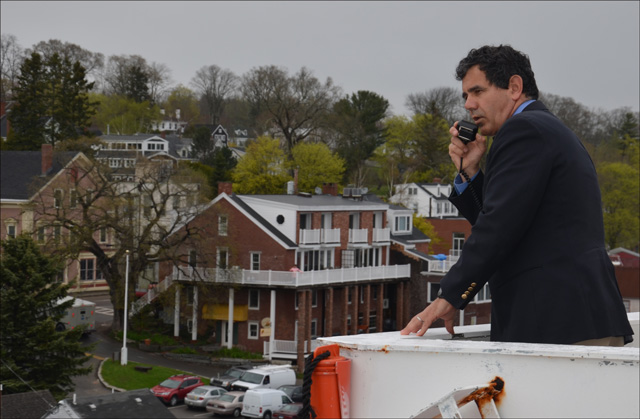
Penobscot Bay Pilot David Gelinas talks with crews aboard the ship from his perch outside the bridge. Below him, the Castine waterfront is alive with wellwishers saying goodbye to the 290 students and staff aboard the State of Maine. (Photo by Lynda Clancy)
The State of Maine technically belongs to the U.S. Department of Maritime Transportation. If there is a national emergency, the ship may get used for disaster relief. That happened when Hurricane Katrina struck Lousiana. The State of Maine went down to the Gulf and served as a hospitality quarters for law enforcement, emergency responders and planners. MARAD oversees all training ships through its National Defense Reserve Fleet.
"When they need it, they can call it up," said Captain John Worth.
Follow the State of Maine's path along the Atlantic via Facebook.
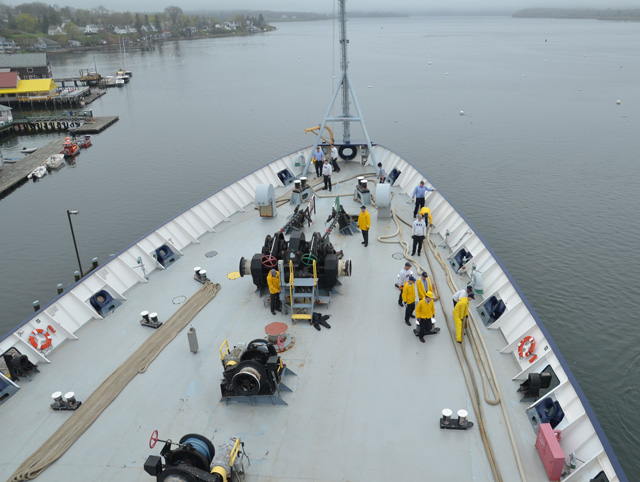
The bow of the State of Maine sits most of the year at the Castine dock, with its bow pointed up the Bagaduce River. It will take monumental thrust of engines and assist from tugboats to turn it around and head out onto Penobscot Bay. (Photo by Lynda Clancy)
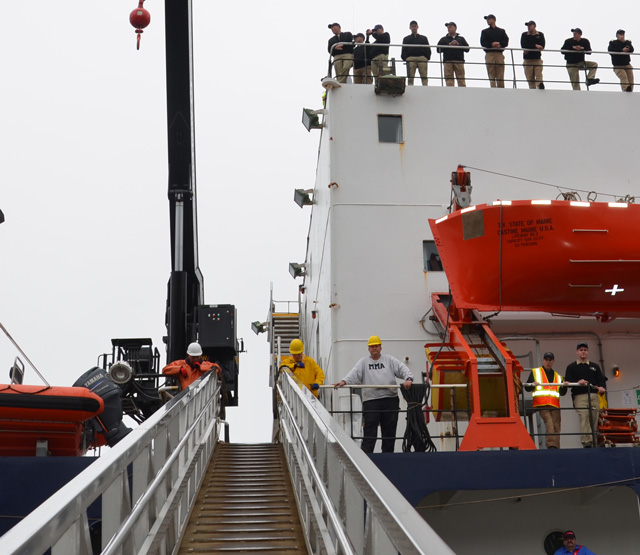
The State of Maine will be at sea for eight weeks before returning to Castine. (Photo by Lynda Clancy)
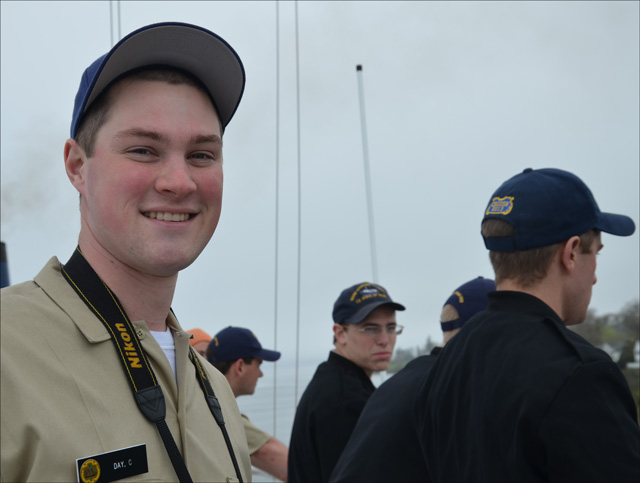
MMA student Cody Almoney is from Auburn. He graduated Central Maine Christian Academy, attended Southern Maine Community College for building architecture and engineering, and now he is at MMA to pursue more engineering education. "This school has been in my mind since junior high," he said. Because he is older, he lives off campus. (Photo by Lynda Clancy)
On board the State of Maine for three to five days were personnel from the Belfast-based U.S. Coast Guard's Marine Safety Detachment. They are responsible for inspecting 86 vessels, the State of Maine being the largest of all. From wood-hulled sailing schooners to commercial craft, the detachment covers 1,500 miles of coastline to the Canadian border. The Coast Guard conducts life-saving drills aboard the ship, and conducts a lengthy inspection with a specific checklist. At the end, if they approve, the ship is issued a certificate of inspection and proceed under way.
"They give us the OK when we've fulfilled the requirements to safely continue," said Capt. Eadies.
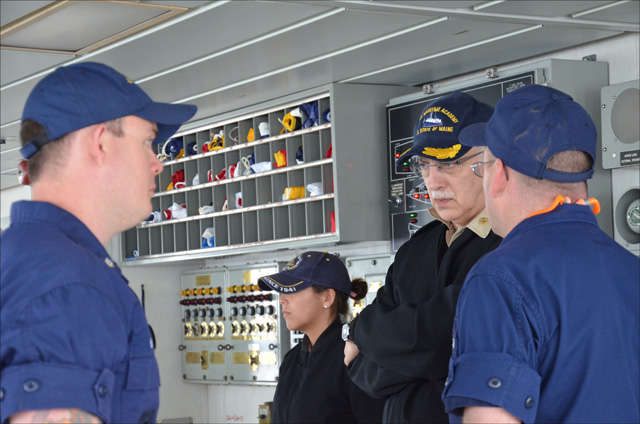
MST 3 Jesse Hagler and CWO Sydney Glass, from the Belfast-based U.S. Coast Guard's Marine Safety Detachment, talk with State of Maine Captain Leslie B. Eadie, III on the bridge of the ship. (Photo by Lynda Clancy)
On this cruise, MMA students and staff will work again with the Belfast-based Educational Passages to launch small unmanned sailboats at various locations, and which sail indefinitely downwind. The boats, 4.5 feet in length and constructed of fiberglass, transmit their location and boat speed via satellite for up to one year. The boats rely solely on wind and current power. Initial sea trials were launched from MMA’s schooner Bowdoin in 2008 off the northeast coast of North America. This is the seventh year that MMA has been helping to launch these boats.
Coordinated by program founder, Richard Baldwin, Educational Passages will work with local schools to facilitate this year’s program aboard the State of Maine. To follow the boats, visit www.educationalpassages.com or contact Baldwin at dick@epboats.com or 207-338-4087 for more information.
The economic function of the State of Maine training cruise is important to the micro-economy of Penobscot Bay, with the entire academy, and much of Castine, involved in getting 290 people out to sea.
"It's quite an economic engine," said Worth. "People don't appreciate what a port does."

The docks of Castine are crowded with parents, friends and media, all wishing a bon voyage to the sailors aboard the State of Maine. (Photo by Lynda Clancy)
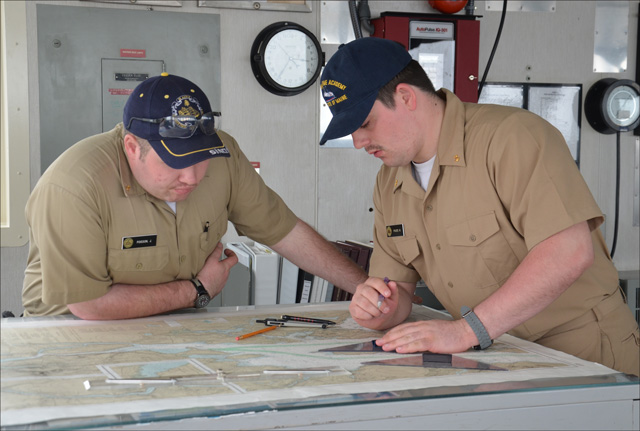
Plotting courses with charts. (Photo by Lynda Clancy)
Captain Eadie sailed tankers for 30 years on the west coast and in the Gulf of Mexico before retiring at home in Brewer. When Al Brown retired as the ship's captain in 2008, Charlie Weeks approached Eadie about taking on the State of Maine.
"I like being able to work with students, and give them the benefit of my experience," he said.

Captain Leslie Eadies III talks with MMA student and Cadet Master Chuck Spear, of Phippsburg, on the bridge. Spear, a member of the Class of 2014, is the captain's right-hand throughout the cruise. (Photo by Lynda Clancy)

Another tradition is to light the cannon at Fort Madison in a salute to the ship, the State of Maine, as it leaves Castine Harbor on its annual spring cruise. (Photo by Lynda Clancy)

Maine Maritime Academy's own training tugboat is the Pentagoet. (Photo by Lynda Clancy)

Andrea West is a MMA junior who grew up on the west coast and is studying marine transportation operations — MTO, the students call it. She is getting more hours at the helm to get her third mate's unlimited license. As the State of Maine slips away from the Castine dock, she and a few other students will take a turn at the helm, listening intently for the orders of Captains David Gelinas and Leslie Eadies III. She decided to study at MMA on the recommendation of her high school guidance counselor because she wanted to study engineering and join the U.S. Navy. She chose MMA, plus, she said, "I liked the scenery." (Photo by Lynda Clancy)
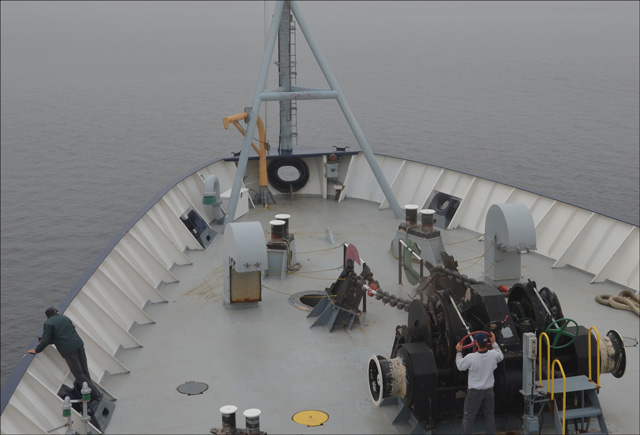
As commands are issued from the bridge, the anchors are hauled up on the deck. (Photo by Lynda Clancy)
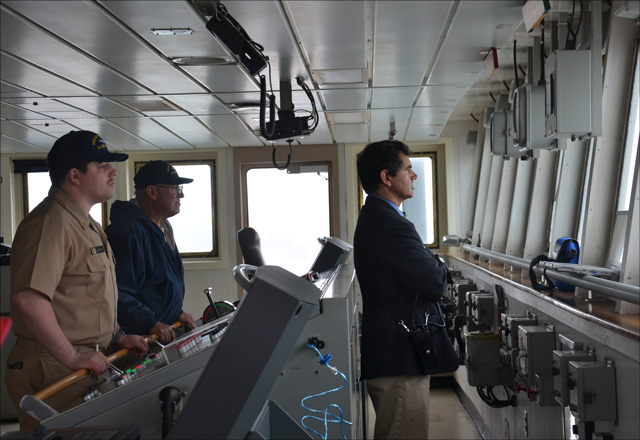
On the bridge, Penobscot Bay Pilot David Gelinas listens and watches as he gets the State of Maine turned around in Castine's harbor. (Photo by Lynda Clancy)
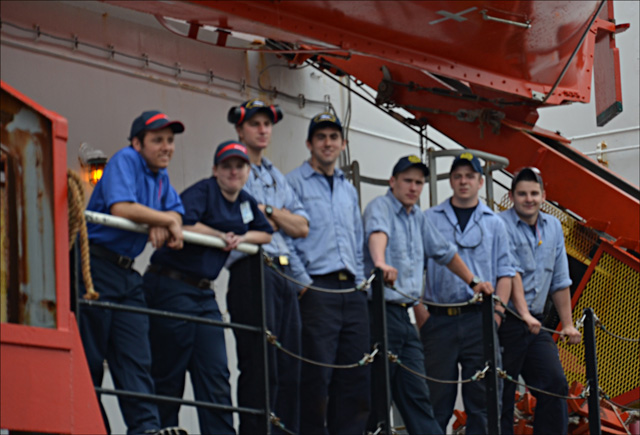
Engineers..... (Photo by Lynda Clancy)
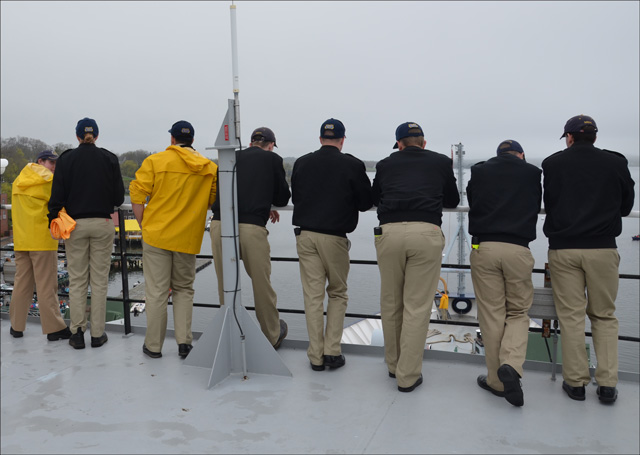
..... and deckies (Photo by Lynda Clancy)
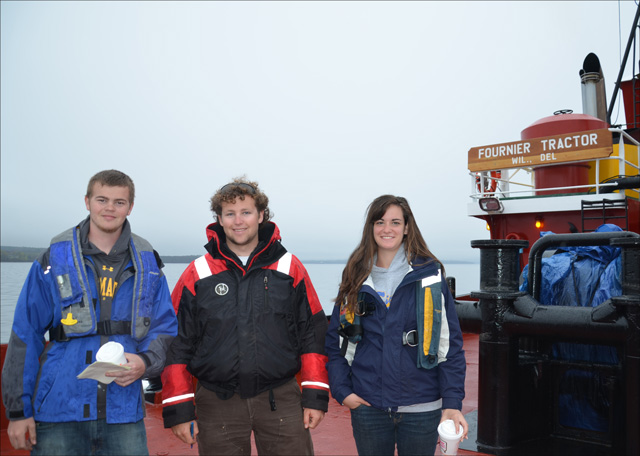
MMA also offers nontraditional academic paths. Evan Motycka is a sophomore studying vessel operations and technology (VOT). Jake Newton graduated May 4, with a degree in VOT. And Brittany Bridgham is graduating with a degree in marine science and VOT. (Photo by Lynda Clancy)



Abe Kilborn, an MMA junior, was on watch on the quarterdeck the morning of May 9. He was responsible for checking identification of all visitors boarding the ship. (Photo by Lynda Clancy)



The tug Fournier Tractor, one of the Belfast-based tugboats, moves the bow of the State of Maine around in Castine Harbor. Captain John Worth is at the helm of the tug. (Photo by Lynda Clancy)

MMA student Kelli Wells, of Kittery, escorts the ship's visitors to the lower deck, where they will descend by ladder to the waiting tugboat, Fournier Tractor.

Editorial Director Lynda Clancy can be reached at lyndaclancy@penbaypilot.com; 706-6657.
http://www.penbaypilot.com/article/penobscot-bay-training-next-generatio...

























